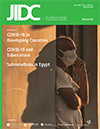Comparing the 2009 and 1997 World Health Organization dengue case classifications in a large cohort of South Asian patients
DOI:
https://doi.org/10.3855/jidc.12468Keywords:
dengue virus infections, 2009 WHO dengue case definitions, 1997 WHO dengue case definitions, Sri LankaAbstract
Introduction: Due to the shortcomings in the 1997-World Health Organisation (WHO) dengue case classification (DCC), a revised classification was proposed in 2009. This study was aimed to assess the clinical usefulness of the two classifications during a large dengue epidemic.
Methodology: Clinical data of dengue patients admitted to selected units at National Hospital of Sri Lanka, Panadura Base Hospital and Nawaloka Hospital Colombo between June and August 2017 were collected prospectively. Cases were classified using the 1997 and 2009 WHO DCCs.
Results: 1,878 patients [adult = 1,573 (83.8%)] were studied. Based on 1997-WHO-DCC-DF (Dengue Fever): 1,316 (70.1%), DHF (Dengue Haemorrhagic Fever) -1: 468 (24.9%), DHF-2: 86 (4.6%) and DHF-3: 8 (0.4%). Based on 2009-WHO-DCC–Dengue with warning signs (WS): 1647 (87.7%), Dengue without WS: 231 (12.3%) and severe dengue (SD): 41 (2.18%). A total of 1,088 (82.7%) DF and 559 (99.5%) DHF patients developed WS. Of those without WS, 228 (17.3%) were DF patients and 3 (0.5%) were DHF patients. Three (0.23%) DF and 38 (6.76%) DHF patients had SD. All SD patients had WS. The level of agreement between the two systems of classification was poor (Kappa = - 0.035, p < 0.001).
Conclusions: The 2009-WHO-DCC was more useful than 1997-WHO-DCC in predicting dengue disease severity as few DF patients also had SD. Furthermore, the presence of WS identified patients with SD. However, the 2009-WHO-DCC may not suit the resource limited countries as WS are non-specific, and lack of diagnostic tests can result in case overload.
Downloads
Published
How to Cite
Issue
Section
License
Authors who publish with this journal agree to the following terms:
- Authors retain copyright and grant the journal right of first publication with the work simultaneously licensed under a Creative Commons Attribution License that allows others to share the work with an acknowledgement of the work's authorship and initial publication in this journal.
- Authors are able to enter into separate, additional contractual arrangements for the non-exclusive distribution of the journal's published version of the work (e.g., post it to an institutional repository or publish it in a book), with an acknowledgement of its initial publication in this journal.
- Authors are permitted and encouraged to post their work online (e.g., in institutional repositories or on their website) prior to and during the submission process, as it can lead to productive exchanges, as well as earlier and greater citation of published work (See The Effect of Open Access).








